Chapter Seven
The Question of Difference:
Isabel Bishop's Deferential Office Girls
I didn't want to be a woman artist, I just wanted to be an artist.
ISABEL BISHOP , December 16, 1982
I hope my work is recognizable as being by a woman, though I certainly would never deliberately make it feminine in any way, in subject or treatment. But if I speak in a voice which is my own, it's bound to be the voice of a woman.
ISABEL BISHOP , 1978
Both "masculine" and "feminine" are not essences, but social categories formed through changing social experiences. They are not only imposed from outside us, they are also experienced subjectively as part of our understanding of who we are. But in a patriarchal culture it is clearly the case that women are forced to adopt a masculine viewpoint in the production and consumption of images far more often than men are required to adopt a feminine one.
ROSEMARY BETTERTON , "How Do Women Look?" 1987
For Isabel Bishop the middle years of the Depression brought a succession of professional and personal milestones. Following her first one-woman show at the new Midtown Galleries in 1933, she met and married Dr. Harold Wolff in 1934. She left her studio-living quarters at 9 West Fourteenth Street, facing Hearn's Department Store; moved with her husband to a residence in the Riverdale section of the Bronx; and leased a new studio at 857 Broadway, with a view of the northwest corner of Union Square (see Map 1). In 1936 she gained considerable attention when the Metropolitan Museum of Art purchased Two Girls (Fig. 7.1). Reviews of her one-woman exhibition in that year and again in 1939 acknowledged her independence of Kenneth Hayes Miller's influence and proclaimed her well on her
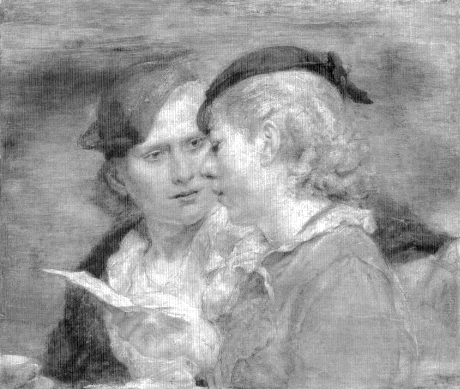
7.1
Isabel Bishop, Two Girls , 1935. Oil and tempera on composition board, 20" × 24". The
Metropolitan Museum of Art.
way to being one of America's best women artists. By 1941 she was elected to the National Academy of Design—the establishment of the American Art world.[1]
Bishop's shift away from Miller's sphere of influence occurred when she set aside the Milleresque shoppers, women at their toilettes, and still lifes featured in her 1933 Midtown Galleries show. By 1936, when Raphael Soyer painted Shop Girls , Bishop had begun to paint Union Square's other working women—the office workers who made up the clerical staffs of the banks, public utilities, insurance companies, and small offices in the district. Whereas the view from her old studio had inspired early works like Dante and Virgil in Union Square and Department Store Entrance (Figs. 2.2 and 3-7), her new studio looked down on the square itself, populated by those she called its "regular denizens": the unemployed men congre-
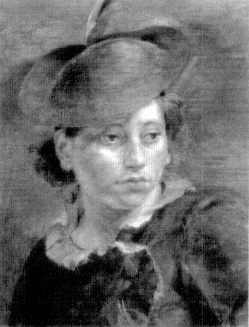
7.2
Isabel Bishop, The Kid , 1935-36. Oil on gesso
panel, 20" × 17". Present location unknown.
gating at the base of monuments who became the subject for paintings like The Club (Fig. 3.39) and for many drawings and etchings, and the young working women, occasionally waitresses but more often than not office girls, who worked nearby. Bishop frequently sat in the park and sketched these girls as they relaxed during their noon-hour break, or she asked them to come to her studio and pose. With the relandscaping of Union Square, completed in 1936, nearly six years after the subway renovations, the park was a pleasant place to go.
Bishop's paintings of youthful, female office workers in the 1930s are sometimes bust-length portraits of individual girls in work clothes, often wearing the exaggerated hats popular in the second half of the decade. Works like The Kid (1935-36; Fig. 7.2), Young Woman's Head (1936; Fig. 7.3), Laughing Head (1938; Fig. 7.4), or Tidying Up (c. 1938; Fig. 7.5 and Plate 7) are penetrating close-up studies of character, physiognomy, and mood. In other works, like Lunch Counter (1940; Fig. 7.6), Lunch Hour (1939; Fig. 7.7), At the Noon Hour (1939; Fig. 7.8 and Plate 8), or Two Girls with a Book (1938; Fig. 7.9), two office workers appear together, usually outdoors and always in shallow, undefined settings.[2] Stylistically, these works combine the artist's respect for established artistic traditions with her modernist practice of structuring and articulating the picture plane. Arranged against a faint grid and thick repeating horizontals, Bishop's studied surface compositions
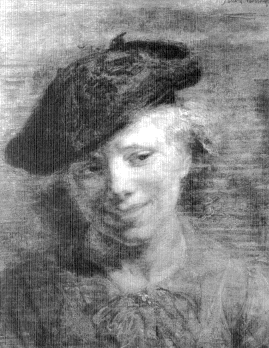
7.3
Isabel Bishop, Young Woman's Head , 1936. Oil
and tempera on gesso panel, 20" × 17". Private
collection.

7.4
Isabel Bishop, Laughing Head , 1938. Oil, 13" × 12".
The Butler Institute of American Art, Youngstown,
Ohio.
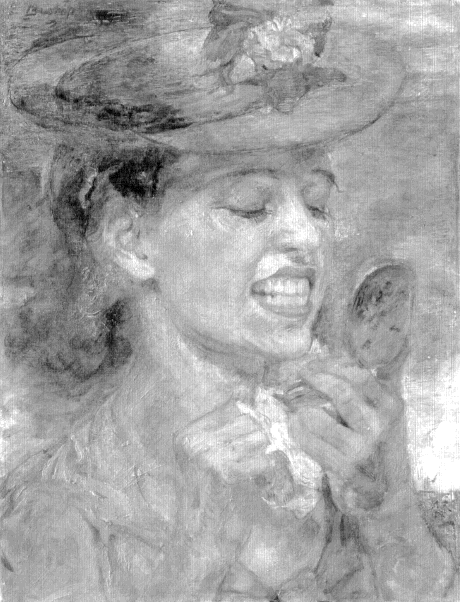
7.5
Isabel Bishop, Tidying Up, c. 1938. Oil on canvas, 15" × 11 1/2". Indianapolis Museum
of Art.
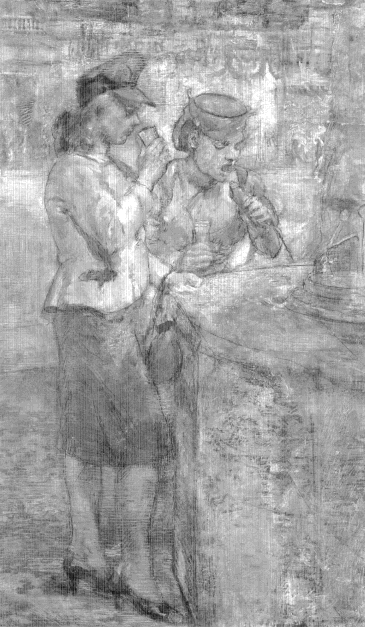
7.6
Isabel Bishop, Lunch Counter , c. 1940. Oil and egg tempera on
masonite, 23" × 14 1/8". The Phillips Collection, Washington, D.C.
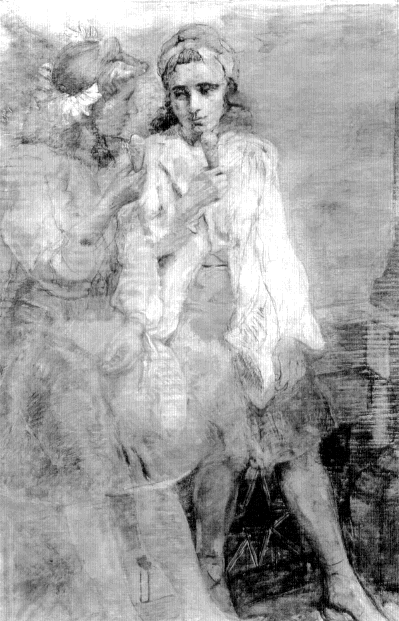
7.7
Isabel Bishop, Lunch Hour , 1939. Oil and tempera on gesso panel, 27" × 17
1/2". Collection of Mr. and Mrs. John Whitney Payson.
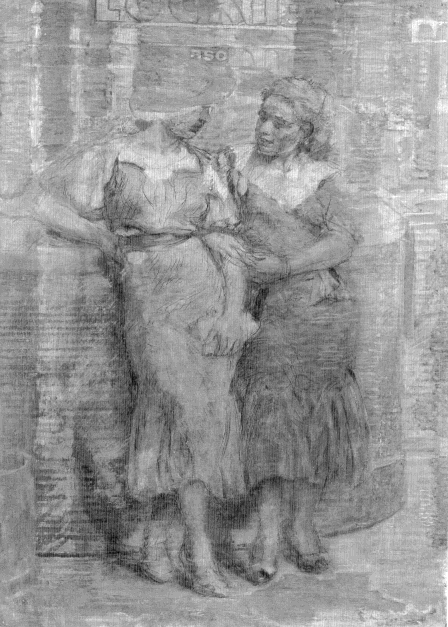
7.8
Isabel Bishop, At the Noon Hour , 1939. Tempera and pencil on composition board,
25" × 18". Museum of Fine Arts, Springfield, Massachusetts.
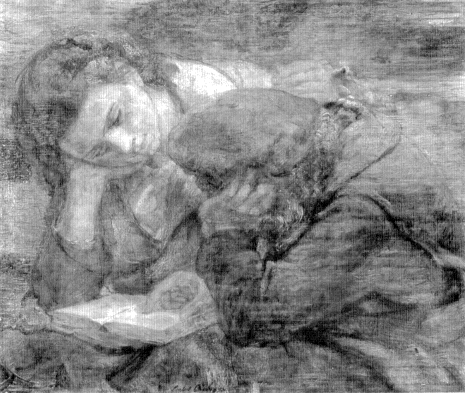
7.9
Isabel Bishop, Two Girls with a Book , 1938. Oil and tempera on gesso panel, 20" ×
24". Private collection.
are animated by fully realized figures, modeled in a soft chiaroscuro and painted with pale amber tints reminiscent of old master paintings. At the same time, her images also draw together conventions of genre paintings—as evidenced by quiet scenes of everyday life around Union Square—and figure studies, in which posed models assume the burden of pictorial expression. Placed in shallow, minimally defined settings outside the working environment, Bishop's relaxed young office workers remain self-absorbed or interact with one another but never directly engage the viewer. They lean on walls, eat ice-cream cones, converse quietly, share a book, or discuss a letter. Often they touch or link arms during their interchanges, suggesting a womanly closeness or camaraderie. Dressed in slightly wrinkled office attire, the women themselves are neither glamorous nor unattractive. Although
Bishop's pictures of neighborhood women were frequently compared to those of her teacher Miller and their close friend Marsh, the comparisons had more to do with their common urban site and the old master origins of their figures than with the types of women they painted. None of Bishop's women become sexualized stereotypes, and none are old enough to be matrons. Her sedate young women bear little resemblance to Marsh's Union Square workers, the blonde bombshells found in images like Hudson Bay Fur Company (Fig. 3.26). And, though stocky rather than svelte, Bishop figures are not made up of the repetitious rounded forms and idealized faces of Miller's shoppers. These are quiet, pleasant genre pictures; nothing about these young women seems striking, garish, unusual, or confrontational.
Bishop's representations of young working women depict a less sexually charged feminine ideal, one deemed more appropriate for the workplace. By embodying in her pictorial language a middle-class ideology of office work that prescribed business conduct proper for women in the 1930s, the artist simultaneously constituted and negotiated class and gender difference. A growing number of interwar publications on women and work championed this same ideology. Statistical surveys and government reports set out the facts about the office worker's job, charting institutional, social, and economic changes brought about by new office technology and the upheaval of the Depression and predicting the office worker's future.[3] These studies were less sanguine in assessing the constant changes in her occupation than were the popular periodical studies and advice manuals that helped to define the ideal office worker and contributed to the myth of occupational and social mobility connected to office jobs.
No matter what the focus of their study, writers for all these publications, many of them women social scientists, social workers, or job counselors, offered women a competitive model of success grounded in a discourse of gender difference and social mobility. Specifically, they argued that if a woman served her superiors with wifely loyalty, behaved deferentially, and dressed modestly, she might advance in her job. More important, in bringing her "natural" caretaking and homemaking skills to the office, she would be preparing herself for the successful marriage that both she and society considered her ultimate achievement.[4] Like the literature of the period, Bishop's pictures constructed an ideal of a modest, deferential office worker without reference to the material circumstances of the typical office worker's life. Her paintings can be aligned with mainstream 1930s thinking on women's roles that was part of the moderate discourse of the revised new woman. Within that discourse, Bishop's works also embody notions of female achievement and class mobility that can be linked to an ideal of liberal individualism. This ideal shaped the way Bishop characterized her subjects and perceived her own role as an artist.
"Difference," Griselda Pollock reminds us, "is not essential but understood as a social structure which positions male and female people asymmetrically in relation to language, to social and economic power and to meaning.... To perceive
women's specificity is to analyse historically a particular configuration of difference."[5] According to Pollock, such gender imbalance in a particular social structure and its supporting ideology fosters a variety of possible and contradictory positions for an individual, all subject to constant conflict and negotiation. Many of these negotiations are played out in visual and verbal texts, themselves products and producers of ideology that are subject to the codes and conventions of their own institutional practice. As a female artist viewing her female subjects, Bishop—sometimes unwittingly—participated in contemporary discussions about women's roles and office work in the 1930s. The way she presented her subjects, within the range of representational practices available to her, simultaneously blurred and clarified the sites where gender and class difference were debated in the 1930s. To paraphrase Rosemary Betterton, I also wish to suggest that Bishop moved between a masculine and a feminine viewpoint in producing her images, thereby carving out a more prominent viewing position for the middle-class female viewer of her work.
By the time Bishop introduced the female office worker into the iconography of American scene painting she had become, like the saleslady, a highly visible member of the workforce. One out of every three New York City working women held some kind of clerical position. The institutions near Union Square alone provided close to ten thousand jobs (see Map 2). At the four main neighborhood banks, women computed interest, counted money, checked securities, made bookkeeping entries, and tabulated customers' accounts. At the Guardian Life Insurance Company, which towered over the northeast corner of the square, employees checked premium rates, risks, and policy expiration dates; sent out bills; and kept elaborate records on all their customers. At the Consolidated Edison Tower on Irving Place just off the square, young women kept meter records and did all the billing.[6] Other buildings in the district housed smaller firms that employed clerical workers for similar routine tasks. Bishop herself observed that "there were an awful lot of small businesses around," and she believed that many of her models and clerical subjects were from these smaller offices.[7]
According to contemporary statistical surveys the women who filed, sorted mail, and typed were usually white, native-born, unmarried, and recently out of high school; Bishop's office girls confirm the demographic profile. In clerical work, the field that had expanded most rapidly for women between 1890 and 1920, native-born white women had always taken approximately 90 percent of the jobs.[8] These women tended to be under twenty-five years of age. A number of polls from the 1920s suggest that white middle-class female workers preferred marriage to a career, and many dropped out of the work force when they married or, more frequently, when their first child was born.[9]
In the 1930s the young female clerical worker continued to dominate the business work force. A 1934 survey of New York office workers found that the median age ranged from twenty-four to twenty-seven years, with women in banks, insurance
companies, and utilities on the low side of the median. A number of businesses, particularly insurance companies that required substantial clerical help, preferred to hire inexperienced workers. Employers usually liked to train and promote from within the organization as upper-level vacancies occurred. Because an immediate superior could rapidly instruct a beginner in routine tasks, most businesses found it uneconomical to search for a worker with particular job skills.[10] According to a Department of Labor Women's Bureau study in the early 1930s, few New York employers required a specific educational background of prospective female employees. Job counselors, however, warned girls against leaving high school to accept clerical jobs because of their dead end-nature. Finally, some companies refused to employ women over thirty for beginning office positions unless special skills were required, and almost no employer wanted college-trained workers at the lower levels: "College women are not satisfactory for the general run of clerical work; they quickly become dissatisfied, and we have always had high turn-over with such women, so usually do not hire them except for jobs that require special training."[11]
To judge from the extreme youth of most of Bishop's office workers, they were beginners and were probably unmarried. The 1930 Census reported that only 18.3 percent of women in clerical jobs were married, as against dramatically higher percentages for women in trade, domestic service, and manufacturing and mechanical industries. By 1934 the percentage had dropped even further.[12] Observers of occupational trends analyzed the statistics in several ways. The economist Grace Coyle, who looked to the economic and psychological states of the women, argued that in agriculture, industry, and domestic service women continued to work after marriage from economic need, whereas women professionals had a desire for "independence, self expression and the use of expert skill."[13] Clerical workers fell somewhere between: they usually married men who could support them, and the work was not challenging enough to keep them in the work force.
At the same time, however, employer and fellow employee pressure against the married clerical worker was stronger than in almost any other occupation. It was much easier, for example, for married women to acquire and retain department store sales positions than office jobs. Some of the pressure was exerted by the traditional ideology of woman's proper place. Coyle suggested that both husbands and employers wanted "to defend the 'American home' from subversive tendencies," and therefore to keep married women at home. Other pressure came from female co-workers. With increased competition for jobs in the Depression, single women workers wanted married women to leave the jobs to those who needed them. In any case, many of the larger institutions had such strict policies against the employment of married female workers that women chose not to report their marriages or retained their maiden names to avoid losing their jobs.[14]
The place of Bishop's women in the office hierarchy is difficult to generalize. Although occupational categories varied with the type of business, larger offices had more specialized and stratified positions; in smaller offices where there were fewer workers—and where Bishop believed many of her subjects worked—office girls shared several tasks. Because the categories of office work required different levels of education and skill, each had a different status. File clerks and junior clerks were at the bottom of the clerical ladder. These were the youngest, least experienced, and least educated, some of whom had left school to take their positions. Next came file and general clerks; Bishop probably painted some of these women since insurance and utility companies employed vast numbers. For these jobs a general high school education was sufficient.[15]
Office machine operators, followed by typists, were next in the occupational hierarchy, making up but a small proportion of the clerical population. Since most women who learned typing also took high school or business school shorthand, they moved into the next higher and more populous category of stenographer. These women, especially in smaller offices, usually performed a variety of tasks beyond taking and transcribing dictation. Bookkeepers, cashiers, and general telephone operators were also at the level of the stenographer. Finally, the secretary was at the top of the occupational scale. She had mastered all the skills of the occupations below her, was given more responsibility, and usually had the privilege of working for a single employer. She was often a woman who had worked her way up from a stenographic position in the company.[16]
From the information compiled, one can begin to draw a composite of Bishop's office worker. She was a young high school graduate, unmarried, on the job for only a year or two. The tentativeness in The Kid (Fig. 7.2) or in the shy interaction of the women in Lunch Hour (Fig. 7.7) suggest her inexperience and her employment in one of the lower-level occupations. The figure in Young Woman (1937; Fig. 7.10), however, is on her own, poised and self-confident. Middle- to upper-middle-class urban viewers of this work, familiar with the business world, might well have identified her as a stenographer working her way up the office ladder.
Bishop's pictorial strategies and her depiction of the appearance and behavior of these women suggest that both her attitude toward the working girl and her conception of that girl's life and job differed from those of Raphael Soyer. Bishop's paired office workers, in Lunch Counter, Lunch Hour (Fig. 7.6) and At the Noon Hour (Fig. 7.8; Plate 8), seem more relaxed than those in Soyer's Office Girls (Fig. 6.3). Unlike Soyer's figures—cropped at the waist, placed against the picture plane, and packed closely together—Bishop's are complete, placed on shallow stage-like settings with enough room to move. Soyer's women move quickly through the environment; Bishop's women are still; either they lean against a wall or sit or stand in relaxed contrapposto poses.
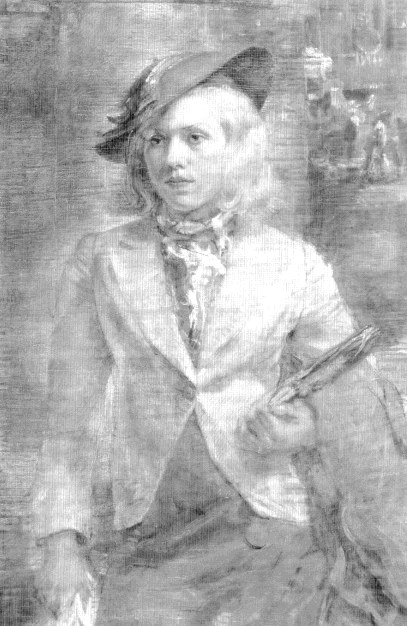
7.10
Isabel Bishop, Young Woman , 1937. Oil and egg tempera on masonite, 30 l/4"
× 22 l/4". The Pennsylvania Academy of the Fine Arts, Philadelphia.
Both Soyer and Bishop depict ordinary women, and both individualize their models. They define the self-presentation of femininity as emotional expression. But Soyer's women are uniformly melancholy or serious. The directness with which they confront the viewer or go about their business suggests further that they have acquired some measure of knowledge and experience. The emotional range—from joy to wistfulness—that Bishop observed in her women was broader and her depiction of moods more subtly nuanced than Soyer's, thanks to the complex transitions between light and dark through which Bishop explores the characterizing topographies of these young women's faces. Bishop used this technique in the patterns that describe, for example, the pointed and slightly jutting chin and narrow eyes in Young Woman's Head (Fig. 7.3) as contrasted with the smoother surfaces of the full fleshy face in Laughing Head (Fig. 7.4).
Soyer's women are psychologically isolated from one another. Group solidarity is achieved only by compositional devices superimposed by the artist. In Shop Girls (Fig. 6.4; Plate 6), linked arms tie the women together, and several other figures who are spatially apart are actually merged through paint. The crooked arms of the two principal figures in the foreground of Office Girls (Fig. 6.3) unify the figures, but there is no suggestion that the women are acquainted; their isolation or self-preoccupation within groups thematizes urban anonymity. Alone among the Fourteenth Street School artists, Bishop regularly painted physically and emotionally intimate interchanges between women. In At the Noon Hour two women lean against the wall chatting, and one links her arm companionably through the other's. Their shoulders and thighs also touch. The same closeness appears in Lunch Hour , where two women rest against the edge of a Union Square fountain, their shoulders touching as they turn toward one another, sharing secrets over the pleasure of an ice-cream cone. In Two Girls with a Book the girl on the left drapes her arm over her friend's shoulder, gazing at her and her book as she traces a line in the text.
Bishop's emphasis on the warmth of these interchanges and the degree of her subjects' engagement with one another overrides, without fully obliterating, the sensuous projection of their femininity toward the viewer. In this aspect of her female imagery, Bishop differs from Soyer and, even more, from Miller and Marsh. Where Soyer's models seem "gently sexualized" on one level, his sympathetic response to them as individuals remains stronger than any projection onto them of masculine desire. With Marsh such a projection is overt to the point of exaggeration; with Miller it is somewhat less obvious. Even where Bishop's models assume more self-conscious poses of display, their provocativeness is never depicted as assertive, nor are they blatantly sexualized. Compare, for example, Marsh's Fourteenth Street Siren (Figs. 3.19 and 5.1; Plate 3) with the taller woman in At the Noon Hour (Fig. 7.8; Plate 8). Bishop's model stands with her right foot before her left, her left hip slightly forward, her right arm akimbo. But her looser dress (almost all of Bishop's women wear softly draped or loosely tailored costumes) masks the
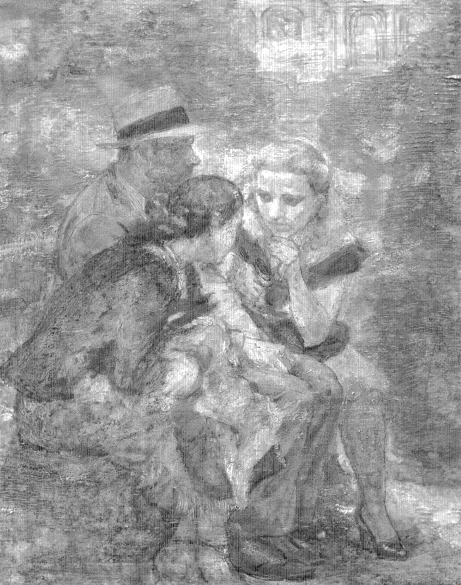
7.11
Isabel Bishop, Double Date Delayed, No. 1 , 1948. Oil on masonite, 22 3/16" × 18 3/16".
Munson-Williams-Proctor Institute Museum of Art, Utica, New York.
curves of her figure. And her energies are directed as much toward her friend as toward an unseen masculine viewer for whom she puts herself on display. In At the Noon Hour , perhaps more than in the other images that feature young women in a shared activity, Bishop captured what she referred to as
a moment in their lives when they are really in motion, because they, of course, are looking for husbands and, at the same time, they're earning their living.... The time that I try to catch them, that I'm interested in trying to present, is when they are in their lunch hour, the hour of respite, when both these things seem to me to be communicated—that is their double purpose.[17]
While it is part of the structure and economy of looking that women in art are available to the masculine spectator, Bishop's paintings construct a larger space for the feminine viewer, producing in turn a greater exclusion of the male.[18] Bishop relegates masculine intervention to the margins of feminine interaction much more directly in a later painting, Double Date Delayed, No. 1 (1948; Fig. 7.11). Here two young women lean across the upright figure of the male, conversing intensely as if he were absent. Banished from the conversation, he is further constrained by their enclosing postures, his discomfort expressed in his slumped pose with hands held together between his thighs.
In paintings of paired working women, the masking of overtly sensuous behavior blunts the intensity of the masculine gaze. These works also envision a same-sex sphere so circumscribed, thanks to the intimacy between the women, that a female viewer—another woman—may comfortably be drawn into the intimate circle. Finally, the space in which looking occurs is itself intimate. Because of the fluid surfaces and a close-value palette employing a narrow range of pastel colors, a viewer is made to draw closer to the works both to distinguish the figures and to observe the intricate surfaces that surround them. Within this closer range the gender-specific transactions occur.
In fact, when these works began to be exhibited in the late 1930s, some of the critical discussion—concerning viewing itself as well as the relative "strength" of Bishop's women—broke down along gender lines. Where Emily Genauer praised Bishop's "clearly defined faces and figures," her "superb draftsmanship and modelling," and her "sensitivity," other critics faulted her "indistinct, nebulous manner" of defining forms. Edward Alden Jewell of the New York Times complained of the need for "an uncommon amount of squinting" to see figures that were themselves too "pallid and frail and washed out to emerge." James Lane, who later spoke of Bishop's "unconventional and glorious" women, initially found them shy, "bloodless and lacking in vigor." Forbes Watson felt that Bishop's "extremely close searching for subtle values" sometimes led to a "neutrality approaching timidity."[19] As male critics described her, Bishop's young woman was a descendant of the fragile steel-engraving lady.
Late nineteenth-century images of women in interiors portrayed the social phenomenon of women's separate, often ritualized, activities; the term homosocial has been used to describe this separate, predominantly domestic, realm of female interaction. In Bishop's paintings, women are depicted carving out a similarly separate and intimate arena, now in the modern urban environment—where women are most susceptible to the masculine gaze. Seen in this light, the works impart a degree of quiet strength to these female intimacies.
Apart from the homosocial content of Bishop's work, its social spaces are similar to those Soyer represents. In both artists' works women are "in transit," outdoors, suspended between environments. But Bishop's environments are so ambiguously defined by her intricate painting techniques that her women are potentially anywhere and nowhere within the settings. At the Noon Hour shifts constantly between foreground, background, and figures, with value shifts and horizontal brushstrokes suggesting several spatial interpretations. One is that the wall on which the two women rest their elbows projects from a storefront glass, on which LUCKIES is printed; this possibility is reinforced by the proximity of the lettering to the picture's surface. Another is that the wall is freestanding and the storefront is all the way across a street behind the women; this is supported by the distance we read into the storefronts in the upper right background. A third interpretation is that we see a reflection of the street across from the women in the storefront glass behind them. Since the letters BSO just above the head of the taller woman appear to be further away than the larger letters, this interpretation also seems plausible. No matter how the picture is finally read, the space is ambiguous, and the women potentially relate to more than one environment.
Although the appearance of Bishop's youthful workers corroborates the historical profile of Depression era office workers, a tension exists between the depiction of ordinary women posed in a seedy neighborhood and the beauty of light, color, and carefully manipulated surfaces that eradicate all references to work. Bishop's firmly modeled figures in works like At the Noon Hour occupy spatially ambiguous settings created either by thick globs of paint that accentuate the surface of the canvas or soft veils of horizontal strokes that blur contours and link figures to one another or to their background. Though formally posed, her women are surrounded and overlaid by this fluid, constantly shifting atmosphere. Such an abstraction of pictorial setting disguises her female subjects' specific identity as workers outside the home and suggests that their spatial and temporal positions are tentative rather than fixed. The figures themselves are equally dynamic, their hands and arms animated by quavering pencil strokes. The fragility and transience resulting from this technique are heightened by the warm light and close gradations of pastel colors that illuminate the women's youthful faces.[20]
There are other things we need to know about these women. What, for example, did their jobs allow them to do, and what did their appearance and behavior signify
in the late 1930s? They are outdoors, away from their working environments, looking pleasant and content and seeming to suffer little from their jobs. But there is also a sense that they renew themselves through repose, quiet conversation, or the refreshment of an ice-cream cone. Their clothing, generally fashionable, looks rumpled, owing to Bishop's scumbled surfaces and sketchy pencil marks. In Lunch Hour , for example (Fig. 7.7), the wrinkles and limpness of the jacket worn by the figure at right detract from an overall impression of tidiness. Such naturalistic touches keep these predominantly optimistic works from being over-idealized or over-romanticized representations of office workers' lives.
Well-established perceptions about office work help us situate Bishop's pictorial language in the broader discourse of women and work. By the 1930s popular books like If Women Must Work, Manners in Business , and She Strives to Conquer celebrated office work as the ideal stopgap for young women between school and marriage: in offices, hours were shorter than in factories or stores or domestic service, the surroundings more pleasant, and the pay better.[21]
Women who took clerical jobs were also attracted by less concrete variables, many of them linked to office work's most seductive, if least tangible, offerings. Ruth Wanger, somewhat simplistic and superficial in her analysis for a high school audience, noted that "office positions are very popular with women. They are what we call 'white collar jobs.'... It means there is no hard manual labor that would soil your clothes or wear them out quickly. As most women like to dress attractively, they want to find positions that do not call for old clothes."[22]
Clerical jobs were valued not only because offices were quieter and cleaner than factories but also because office work provided a chance to get ahead—to achieve what economics professor Grace Coyle defined as "the rise to business success so highly esteemed among us."[23] Within the office a young woman could rise to the top of the stenographic pool or even, in rare cases, achieve executive status. The social interaction in an office was considered superior to that in a factory or department store. In a small office a young woman whose parents had been manual laborers could transcend class and social background through interaction with better-educated superiors. The work itself remained free of the stigma of manual labor, allowing the office worker to achieve a middle-class standard of femininity. Interpersonal relationships in an office could stimulate a woman to greater personal achievement and loyalty to her institution. The institution in turn could reward her with promotions and better pay.[24]
Given this situation, the fluidity of Bishop's surfaces can be read in two ways: it destabilizes the position of the woman as a worker with access to economic power even as it unfixes the boundaries of gender and class to project the possibility of such access.
In fact, the blurring of boundaries seems to have been Bishop's goal. As early as 1939 the artist equated her formal quest for "painterly mobility," manifested in
her intricate painted surfaces, with the possibility of social betterment for her subjects. Mobility, as she worked it out during her career according to a loose Wölff-linian model of stylistic analysis, was not movement per se but the potential for movement.[25] "To express that potential by visual means is a very subtle business. You can't describe it in words, it has to be expressed in the modeling. To express it in the modeling there has to be created in the onlooker . . . a sense of physical continuity as by a subtle and delicate web throughout the picture."[26]
Bishop viewed the continuous horizontal strokes in her works as the web that links her figures to the environment and thereby suggests mobility in these otherwise still figures. In extensive discussions of her 1930s imagery held prior to her 1975 retrospective exhibition, Bishop reiterated her goal of showing these office workers' potential for upward mobility in American society. Her theory of painterly mobility as a metaphor for social mobility was also based on her sense that one could identify the lower classes.[27]
It seemed to me that in order to say what I felt I wanted to say about them, girls or men had to be classifiable. I don't think you can classify the upper middle class. The upper middle class is not definable in our society, but these young people are class-marked in the sense that you understand they are socially limited. But what I feel about them—and I really do feel strongly about these things—is that I know so many instances where, if they want to move, in a social sense, they can and it's that mobility that connected for me.[28]
Bishop amplified her statement, emphasizing her optimistic view of upward mobility.
I was conscious of their being class-marked, but not class-fixed. If I succeeded in making them seem to the onlooker that they could turn and move in a physical sense, this opened up a subjective potential which could include the mobility of content. I mean it made it possible to suggest, or at least the suggestion was already there, to my mind, that if a physical movement takes place who can tell what other kind of movement might take place.[29]
Bishop's concern with her subjects' potential came in part from her own early awareness of class and gender difference. The artist's childhood home was located next to the urban working-class neighborhood in Detroit where her father was a poorly paid high school Latin teacher. Because both parents were from upper-middle-class families and wished to maintain the appearance of that position, social contacts with the neighbors were minimal. Bishop recalled in a 1975 interview that "though we didn't have the money, we identified with the big houses on the next block. I wasn't supposed to play with the children on my block or be connected with them but I wanted to be. I thought, 'Oh they have a warmer life than I do— they all know each other and see each other and we are isolated.'"[30]
Caught between two social classes, Bishop learned about the restrictions and exclusions of each and acquired her own attitudes about social limitation and social mobility. When she came to New York in 1920, her fortunes changed. She received a monthly stipend from a well-to-do relative that allowed her to concentrate on her education and to move in circles with artists of her own social, educational, and now economic circumstances. Her economic support continued until 1934, when she married Wolff, a prominent neurologist.[31] Bishop recognized that her changed economic situation allowed her greater occupational and social mobility—advantages not accessible to her subjects—but she was nonetheless optimistic about the relation between social mobility and individual initiative. The artist credited much of her own success to a rigorous six-day per week work schedule and to her slow, thoughtful production of images. Her story, and the one she envisioned for her subjects, was, in some ways, a version of the Horatio Alger success story, now told with female characters.
Bishop's depiction of warm, intimate relationships between working women was in part the outcome of a working process in which a female producer of images of female subjects promoted same-sex interactions that drew in both the artist and the female viewer. It was not until Bishop stopped painting friezes of shoppers in the Miller mode and turned to images of Union Square workers that she began to employ nonprofessional models on a regular basis and to sketch from everyday life in Union Square. She also made clear at the time of this transition that she wanted to portray more than modern women's "superficial" exteriors:
I don't think I could ever use a professional model again. It makes a great difference, because I try to paint people who are trivial outside and show that they are decent and good inside.... There is a great discrepancy in American women.... Their hats and clothes make them look like flibbertigibbets, light as air, when they are not. Traditionally, we show silly people in silly clothes, and the housewife with her hair done up and in a gingham apron. But that is an anachronism. It isn't true of the modern world.[32]
When she began to use nonprofessional models, she also expanded her method, making dozens of sketches, followed by etchings, to capture a specific moment or gesture for a painting. In effect, Bishop was setting up female-centered working conditions in the space of her studio with women who were, like herself, meant to be understood as modern working women.
The depiction of same-sex intimacy was in part a reference to her own onetime wish to join her working-class neighbors' "warmer" interactions. Yet the dynamics of the artist-subject and artist-model relationship must also be read as the simultaneous acknowledgment or assertion and diffusion of class and gender difference. Bishop admitted in interviews that by the time she was an established artist, she no longer envied her subjects' lives. Nor did she want now to take part in them. More-
over, she was very clear about the types of women she portrayed and invited to her studio. Though art critics occasionally described her subjects as shopgirls, Bishop claimed that she had never painted "any of them"; their class and occupational status were lower than those of the office worker.[33]
A 1936 newspaper article characterizing the artist-model dynamic involved in the production of Two Girls defines the professional distance Bishop maintained in interactions with her subjects. She asked a waitress from Childs', where she regularly had breakfast, to model. Miss Riggins agreed and brought a friend, Miss Abbott, with her to the studio. Almost every day for six months the two waitresses sat for Bishop. As Miss Riggins described it, she and Miss Abbott—the two women married and lost touch with each other until the newspaper piece brought them together—talked about everything from movies to boyfriends to fashion while Bishop worked. Bishop wrote of the period, "I never did know their first names. They'd come up from Childs' and just sit and talk. I don't know what about. I couldn't tell if I had to. I made dozens of sketches of them. Finally I thought I had something."[34] Although Bishop's same-sex interest in her subjects enabled her to depict a relationship of female intimacy, class and professional distance kept her from forming bonds with her subjects. This distance can be read as respect, professionalism, or neutrality, but it is also consistent with objectifying the models in terms of class. Though class distance in Bishop's works is never what it is in Marsh's, it remains, now strongly modulated by the commonality of gender.
Even so, Bishop wished to blur class and gender divisions, to infuse her imagery with her own optimism about the possibilities for working women. Though she idealized her ordinary models through the use of pastel tones and light, she never wished to divest them of their individuality. A comparison of photographs of her models for Two Girls with the painting (Figs. 7.1 and 7.12) demonstrates that she retained the look of the actual women while suffusing their features with a soft light that emphasized their youthful seriousness. Of Miss Riggins, the woman in profile, Bishop wrote,
I didn't think she was extremely beautiful or American or Hindu or 14th street or anything. I said, There's an interesting face. It didn't matter what she wore or how she fixed her blond hair. I wanted to paint her as she was, somehow and give the feeling that it didn't matter about the outside appearance the looking glass shows. I wanted to do her as a person.[35]
By seeing her women as self-sufficient individuals in a subtly shifting environment rather than as sexual stereotypes, Bishop conveyed her own optimism about working women and American life in general toward the end of the 1930s. She also attempted to suggest that these women could transcend the limitations of class, sex, and occupation, much as she had by achieving success from a marginalized position as a woman artist in the mid-Depression. She believed that they had freedom of
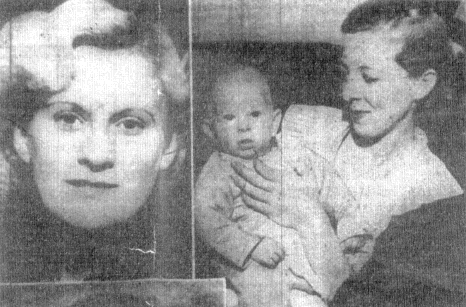
7.12
Mrs. Anna Sweeters (Miss Abbott) and right: Mrs. Rose Hirschberg (Miss Riggins) with
her daughter Sally. Photographs accompanying William Engle, "Portrait of Two Girls
Bought by Metropolitan, Reunites Two Ex-Waitresses Who Posed for It," New York
World-Telegram, February 27, 1936, p. 3.
choice, even if economic evidence suggested the contrary. Bishop's professed attitudes and her general liberal humanist stance can be read in terms of women's potential for achievement and in light of the broader political assertions of individual rights in the Popular Front movement. Bishop's late participation in the Artists' Congress and her secession from it to join the more pluralist Society for Modern Artists suggest her awareness of her own social and political agenda.
As a consequence of her upbringing, her experience as a woman artist in a male-dominated set of art institutions, the value humanism placed on an old master tradition, the discourse of new womanhood that celebrated the virtues of individual achievement, and her place within a specific political context of ideas, Bishop brought middle-class values and expectations to the studio, where she produced her "realist" representations of working women without engaging them in situations that spoke about their lives. In Bishop's view neither the working women nor Union Square's unemployed men, who also became subjects in her paintings, were
the victims of society, or of an inegalitarian culture, or of ideology. Bishop wrote or spoke about this often in conjunction with the unemployed men she painted. She denied that she was socially conscious in painting these men in the Depression, claiming that they were "aliens by temperament," eccentric and not to be pitied: "I don't say their economic disadvantages haven't something to do with their condition but essentially they are persons who are eccentric. They are really hedonists. I got to know them as I had a series of them come up here [to her studio]. They would bring each other and they would take anything they could lay their hands on." She also acknowledged that her intent in her images of these men was nothing like that of Soyer, who sympathetically portrayed men unemployed as a result of the Depression whereas Bishop's men were a regular feature of any society. As a genre painter preoccupied with the characteristic movements of the human figure, she endeavored to capture their routines. Her more "generalized" intent allowed her to position herself outside the debates on art and politics that frequently intruded on discussions of subjects connected to the Depression.[36]
Although the park remained relatively seedy throughout the 1930s, Bishop felt safe sketching there and was accepted as a regular by the unemployed men. She recounted (interview, December 16, 1982) that on one occasion, however, a drunken man reproached her for making fools out of the men who lived in the park. When she chose not to respond to his continued questions, others gathered around and began to accuse her of exploiting them by selling her sketches to Life magazine. She ended by giving them the sketches and edging her way out of the park, where a policeman asked her if she really needed to sketch inside, suggesting it was hardly the proper environment for a lady. Bishop felt that her refusal to answer her accusors' questions transformed her from a regular occupant of the park into a capitalist "lady"; had she simply responded to the men, the hostilities would never have occurred.
In his 1975 article on Bishop, the critic Lawrence Alloway faulted Bishop's upper-middle-class worldview, in which social mobility results from diligence. The artist's theory of painterly mobility as a metaphor for social mobility remained unconvincing, Alloway argued, because "the fact that you can cross the street does not mean that you can cross social barriers in the same way."[37]
In fact, by 1936, just as Bishop began painting office workers, many of the occupational advantages that had once made clerical work seem a path to upward mobility were rapidly disappearing. The economists, social scientists, and job counselors who compiled statistical studies and wrote the rapidly growing body of advice literature for women entering the working world came to recognize that office workers' lives and expectations had altered drastically.[38] Wages dropped dramatically with the Depression, and socially conscious researchers, aware of the cost of living for workers, claimed that reports of high wages had been exaggerated even before the crisis.[39]Fortune magazine, in its lengthy analysis of the office worker's
life, attributed low office wages to the youth of most office workers, who were under thirty and retired from the workplace with marriage: "The American office, to a great part of its female workers, is not a career but a device by which a woman works her own way through maidenhood" and into marriage.
Capitalistic economy, which takes into account not only economic but social factors, has profited from this circumstance as might be expected. If the great majority of office girls were in business not for the business but for their lingerie then there would seem to be no particular reason why business should not reciprocate in kind. The girls, since their ambition was elsewhere, would not complain and business, since its ambition was itself, would profit. The consequence is a low, sluggishly rising, and generally despondent wage scale paid by business with a fairly clear conscience and accepted by the young ladies faute de mieux .[40]
In short, the ideology of office work, buttressed in part by statistical evidence, operated with that of woman's proper place to justify keeping the wage scale low.[41] Underscoring employers' views on women's lack of economic and career motivations was evidence that males in clerical positions earned twice as much as women and advanced more rapidly.[42]
Apart from diminished wages, working hours during the Depression were frequently extended in smaller offices and jobs combined. While some institutions failed during the crisis, creating an ever diminishing job pool, others stopped hiring. Of all the low-level white-collar fields, except sales, office workers suffered most from unemployment.[43] When businesses started to hire again following the brief economic upturn in 1936, there was a new problem—an oversupply of office workers. "Business at its rosiest could not possibly absorb all these girls," wrote Helen McGibbon. Many job counselors faulted the high schools for overdeveloping office-training programs and for failing to counsel women away from the standard feminized occupations like office work and teaching.[44] Since competition for these jobs was keen, women accepted low wages and beginning positions rather than have no job at all. As one writer observed, "Too many girls everywhere are still walking into employment agencies, vague and untrained, with the hopeless statement: 'I'll take anything.'"[45]
Technological change and the reorganization of offices bred dissatisfaction among those who found jobs. With more sophisticated office machines and the scientific application of mass production, workers who had previously executed a variety of related activities now performed repetitive tasks in stenographic pools, supervised by an office manager who distributed projects like a factory foreman. With the increasing centralization and specialization, some offices adopted methods of payment used in factories, setting piece rates for typing, billing, and transcribing.[46]
The streamlined procedures that helped businesses reduce higher-level staff and distribute work more efficiently had negative effects on the office girl. Because they reduced the number of coveted secretarial positions, they necessarily altered her expectations for improving her status. Work became boring, and offices reported more illness among those engaged in single repetitive tasks. The office machine operator lost track of how her job contributed to the business as a whole, and as a result her loyalty to the institution diminished and she felt alienated from coworkers and superiors alike. As job mobility diminished—one contemporary survey reported that 88 percent of office managers sought clerks who would be satisfied to remain clerks—the office girl became another cog in a vast production machine.[47]
In luminous outdoor settings, away from the workplace, Bishop's youthful office workers seem impervious to changes in the office environment. The only possible markers of labor and class are their costumes and occasionally sober expressions. More than other Depression era images, Bishop's paintings appear to preserve a disappearing ideal of female labor. This ideal was foreign to Raphael Soyer, even though he, like Bishop, used everyday outdoor settings, sketched on site, and arranged figures in studio poses. But with his spatial configurations, lighting, and palette in a work like Office Girls (Fig. 6.3) Soyer conveys some of the tension, monotony, and fatigue of women in routine jobs. They are crowded in an urban setting, placed directly against the picture plane, and surrounded by other figures. The pace of urban life prevents human interaction and repose. One figure rushes quickly by and another looks out, engaging the viewer with her weariness. Soyer's backdrop, unlike Bishop's soft veils of color and light, is one of dark, roughly painted office buildings. Finally, the figure of an unemployed man, at left, serves as a reminder that the economic crisis continues.[48]
Though Soyer was more cognizant than Bishop of the effects of the workplace, his image, like hers, avoids direct engagement with the socially problematic issues of women's labor. Drawings from the Communist periodical the New Masses use the direct, sketchy conventions of graphic media to show the clerical worker as exhausted, or at least hardworking—conventions that since the turn of the century had come to be associated with images of social protest.[49] In M. Pass's 1926 drawing of a typist (Fig. 7.13) the monotony, fatigue, and meager rewards of repetitive clerical work are crystallized in the image of a typist agonizingly bent over her machine. Similarly, William Siegel's "Office Worker's Lunch Hour" (Fig. 7.14) shows a poorly clad young woman looking up from her portion of bread (in contrast to the delights of the ice-cream cone), seeking release in the light from the urban prison that surrounds her. By contrast, Bishop's paintings avoid negative social commentary or any expression of a need for dramatic change. Instead, the clerical worker relaxes in an obscured outdoor milieu. Having fashioned a deliberate construction of womanhood according to her interpretation of artistic conventions, Bishop contributed to what in turn became part of the rhetoric defining the exemplary office worker.
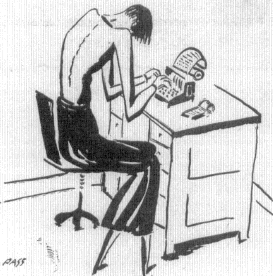
7.13
M. Pass, drawing of a typist, New Masses 1 (May
1926), p. 27.
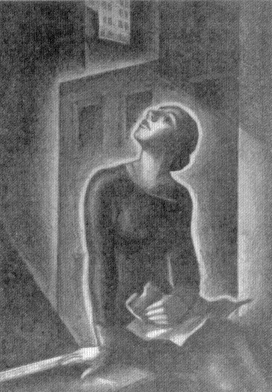
7.14
William Siegel, "Office Worker's Lunch Hour,"
New Masses 5 (April 1930), p. 13.
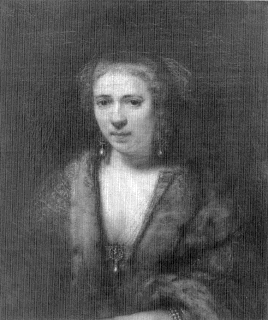
7.15
Rembrandt, Hendrickje , undated. Oil on canvas.
Louvre, Paris.
Like other painters who drew on the tradition of old master painting, Bishop regarded her women as figures to sustain aesthetic beauty in a work of art. Rembrandt, who often portrayed ordinary women, provided Bishop with a more appropriate model for her working women than either Titian or Rubens, whose more sensuously beautiful nudes inspired Miller and Marsh.[50] Bishop's works, like many of Rembrandt's portraits, depict reflective women or women responding to someone or something outside the confines of the picture. The more enigmatic figure of the woman on the right in Lunch Hour (Fig. 7.7) recalls, for example, Rembrandt's quiet portraits of Hendrickje (Fig. 7.15). Rembrandt's warm understanding of human relationships, like those depicted in The Prodigal Son and The Jewish Bride , touch Bishop's interpretations of intimate exchanges between women, which for some critics are even more sympathetic. Indeed, Lawrence Alloway wrote that her portrayal of women "has an acumen and an empathy that . . . neither males nor sexually mixed subjects elicit." Alloway argued further that Bishop needed two women to obtain these qualities, for "without that she cannot depict the web of mutual responsiveness which is at the core of her meaning and which is rarely found in the history of painting couples."[51]
Even though her subjects may not be glamorous or beautiful, Bishop thought of women as beautiful forms—subjects of beauty in a painting; they are woven into
the texture of the painting as surface, color, light, and space. Bishop modified many of her Rembrandtian sources, particularly techniques from some of Rembrandt's later works. She spotlights certain areas of the faces while leaving other areas in shadow, and she obliterates contours. She sometimes applies paint with a heavily loaded brush (see, for example, the hair and faces of the two women in Lunch Hour ), creating thick impastos or flickering highlights. Although no one source for either subject or technique is exact, Rembrandt was important in Bishop's capturing the modest humanity of her young office workers—in her creating a different model of womanhood and a different kind of working woman.[52]
Bishop's idealization of young women using an established model of artistic beauty assumed a particular meaning in the 1930s, when the office worker's prettiness became increasingly important to her job. Job counselors suggested what job applicants should wear and how they should behave, resorting to strategies that capitalized on conservative ideas about women and their role. They encouraged the practice of sex-typed behavior—the occasional use of flattery or sex appeal—but more often advocated modest dress and deferential manners.[53]
If Bishop's young women look reasonably fashionable, it is because they had to be. Dozens of job advice manuals contained some version of the following counsel:
A business girl may be a mental giant with every qualification for the job she seeks, but that won't help her half so much as wearing the right clothes and make-up and looking clean. Theoretically, one's appearance should have nothing to do with getting a job, but it actually counts 75%.... Gone are the days when a girl could look dowdy at the office and get away with it. You no longer hear an employer say of his secretary "she doesn't look like much but how can she type!" He is more apt to say, "I've an A-I secretary now, and is she a looker!"[54]
Employers justified their selection by equating good looks with good work. But they also wanted the proper decor for their offices, and women were encouraged to make themselves into ornaments.[55] When asked if he selected pretty, well-dressed women more often than others, one employer replied that he did, especially around June when graduation presented him with more "girls" than jobs. The reasons were clear:
Partly to make our office look attractive. Partly because good looks, a good carriage and clear skin, are symptoms of good health which is of serious interest to an employer. And partly because we think that the kind of girl who takes pains to make the most of herself in every small detail of her appearance will also be orderly and painstaking in her work. It isn't always true that a girl who pencils the curves of her lips skillfully is quick and deft. But the converse is often true, that the girl who is careless of her appearance is not a good office worker. So we don't hire her.[56]
Despite such preferences, most writers agreed that "prettiness" depended more on good grooming than on glamour or sex appeal. Bishop focused on this particular preoccupation in Tidying Up (Fig. 7.5; Plate 7). With a light touch, she captured the young new woman "revising" herself in that most awkward of grooming moments, when she grimaces into her compact to check for lipstick on her teeth. Job manuals in the 1930s, forerunners of 1970s and 1980s dress-for-success guides, advocated moderation in all details of dress and fashion. Writers recommended against large flashy jewelry, bright makeup, and bright-colored clothes. Recognizing that most business girls operated on small salaries (and marveling at the clerical worker's ingenuity at dressing well for so little), counselors suggested conservative clothes, coordinated around a single color (preferably black, navy, gray, brown, or dark green), that would last for several seasons. Most appropriate were tailored dresses and suits in plain colors with white or matching blouses. Ornate trim belonged on afternoon dresses, which were out of place in the office. The higher women went on the occupational scale, the more simply they dressed.[57]
By such standards, many of Bishop's office workers appear appropriately fashionable. The subject of Young Woman is the very model of fashion success (Fig. 7.10). Her short jacket with its single button and wide lapels resembles styles from the middle of the decade. With her tailored suit, neatly brushed blond hair, and poised demeanor, she looks like the self-confident business woman about to be met by an American Express travel representative in a 1937 advertisement that reads, "A lady alone enjoys the luxury of American Express Travel Service" (Fig. 7.16). Other Bishop women seem less well turned out, like one young woman in Lunch Hour who wears a blouse with puffy sleeves. In At the Noon Hour (Fig. 7.8, Plate 8) the women wear dresses with flounces—the kind of sheer, fluffy dress deemed inappropriate for office work. Among successful office workers like Miss Kay Bell, pictured in the Fortune article of 1935 (Fig. 7.17), the tendency was toward understatement. When the private secretary trimmed her dress, the effect was still severe and geometric.
Despite Bishop's disclaimer (see p. 294) contemporary critics singled out these women by their dress and called them shopgirls, lower-class workers in a lower-status occupation. And even if they were mistakenly identified, they were not necessarily dressed for success. The reviewers linked assumptions about the class makeup of the neighborhood to the women themselves despite Bishop's light-filled ambiance, which eradicates the neighborhood's reported tawdriness. The critics' comments suggest how these women were seen by the middle- to upper-middle-class audience viewing Bishop's work. Bishop's stated intent notwithstanding, these young women were limited by their social backgrounds, which marked their speech, or by their clothing, which, though fashionable, was clearly purchased at Fourteenth Street bargain stores. One reviewer called the shopgirls "portly faced female subjects" seen with "the mixed collection of humanity gathering on New York's
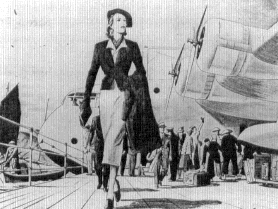
7.16
Advertisement for American Express Travel Service,
Harper's Bazaar , September 1, 1937, p. 159.
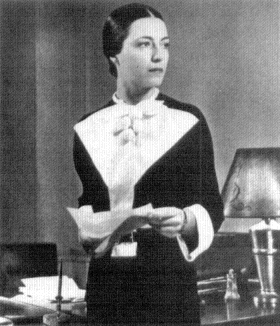
7.17
Photograph of Miss Kay Bell, from "A Portfolio
of American Office Workers," in "Women in
Business II," Fortune 12 (August 1935), p. 52.
squalid avenue of shoppers, 14th street." Another went so far as to attribute to the women he identified as shopgirls in At the Noon Hour a lower-class manner of speech: "They talk in that peculiarly harsh and grating dialect called New Yorkese—Toird Avenue, terlet water, olive orl, idear, Greenpernt and Americer."[58] Job counselors claimed that the successful well-bred office girl would bring a well-
modulated voice and correct usage to the office from her previous social training. By the late 1930s schools and business colleges offered self-development courses that included voice culture to help the aspiring office girl with an accent or dialect to modify her tones.[59]
Besides trying to be pretty, fashionable, and well-spoken, the young office girl competed for jobs by cultivating a modest, deferential manner. She adopted the new womanhood exemplified by Dorothy Bromley's "feminist-new style," her voice and gesture demonstrating the "feminine" qualities intended by "nature." Bishop's pictures show a narrow range of behavior in pose, gesture, and expression. Often serious, these women appear gentle and straightforward in their attentiveness to one another. Many stand in relaxed poses, confining their gestures to subtle inward motions. Their demeanor seems passive and responsive rather than provocative. When the subjects seem flirtatious, as in Young Woman's Head (Fig. 7.3), they are charming, never raucous or overtly sexual. Fundamentally, they are more receptive than argumentative, and they never affront.
The right personality supposedly had everything to do with obtaining, keeping, and advancing in one's job. Counselors devised recipes, which included a dash of polyvalent charm mixed with the right blend of efficiency. Hazel Cades in Jobs for Girls defined this "right attitude" as a perfect balance of irreconcilable polarities.
It is difficult to define charm, and popularly it is not supposed to be a factor in business, but it is and if you have it you are apt to stand a better chance of getting the job you want.... Sometimes in business it is called the right attitude and it is really a combination of friendliness and reticence, of assurance and modesty, of ambition and willingness to do anything, of today's accuracy and tomorrow's vision. It is the ideal attitude of the girl who is willing to take any job and work hard at it while she admits no ultimate limitations.[60]
Job counselors recognized that women were relegated to mechanical and boring jobs. They no longer hid the nature of clerical work. Now, however, they encouraged women to show an interest in their menial tasks, strengthening the chain of production through personal dedication to the company and its goals.[61] By encouraging the right attitude, job counselors perpetuated a myth of easy advancement even as a decrease in the number of skilled secretarial positions lessened the possibilities for rapid upward mobility.
Job prospects were brighter for women willing to be passive and compliant. Hortense Odium, even from her position as president of Bonwit Teller's Fifth Avenue Store, advised that "the greatest asset of the business woman is feminine charm and feminine clothes.... Don't wear the pants, men are the leaders."[62] Odium believed that it was fine for women to work, as long as work never undermined their femininity and they remained aware of their naturally subordinate role as women.
From all quarters women were advised to defer to everyone else's needs. In a book implausibly titled She Strives to Conquer , Frances Maule advised women to surrender their will and freedom to the interests of superiors. Other writers advised women to dust a male boss's desk, run his wife's errands, and perform a host of other domestic tasks—no matter what the cost in overtime or the personal sacrifice—to get ahead. Fortune magazine's long 1935 article on women in business was the most overt attempt to validate women's subordinate role in the workplace. Its author claimed that a woman's intention to marry and her willingness to be directed by a man relieved her of the ambition that would have made a man restless in her job.[63] Moreover, the boss needed her in this job because social and economic change had created a "new woman," one vastly different from the dutiful upper-class Victorian model. A man, instead of being master in his home, was now the mate of "a more or less unpredictable woman," and he "resented it." The new office worker (especially the private secretary) replicated the woman his father had married, a daytime wife who knew "all the affairs, all the friends, all the friends' voices, all the idiosyncrasies, all the weaknesses of one man."[64]
A woman's "power" in the workplace came from her ability to behave in a deferential "womanly" manner according to an ideology that valued her subordination to the demands of male superiors. Since office work depended on a woman's extending her reputedly natural domestic skills to the public sphere—where she made the work environment more pleasant and inviting and managed the office efficiently—she achieved a success with which men could not compete, one that, as the Fortune author concluded, "was a triumph for [her] womanhood and not for [her] ambition."[65]
The pictorial narrative structure of Edward Hopper's painting Office at Night (Fig. 7.18), one of the few paintings of the period that shows a secretary in an office, encapsulates the contradictions in popular advice literature. It gives visual form to the ambiguous power and gender relations embodied in the boss-and-private-secretary or male-and-female relationship. The secretary has power. A fully realized figure, she towers above her boss and controls not only the access to and organization of office information (the filing cabinet) but also office "production." In the visual field, Hopper emphasizes the secretary's desk and typewriter. They protrude into the lower lefthand corner of the painting, and along with the filing cabinet and the boss's desk they become an important third term in the painting's triangular configuration of work. The secretary's power is subverted, however, by the very stance that affirms it. She is the ultimate office ornament, a male painter's construction of objectified womanhood; her impossibly twisted seductive posture displays her breasts and buttocks simultaneously for both the male viewer and, should he look, the boss. She "controls" the office decor with her beauty and her simple attire—a plain blue dress with a white collar. But her dress clings to her body, whose curves are emphasized by the chair arm which insinuatingly penetrates the
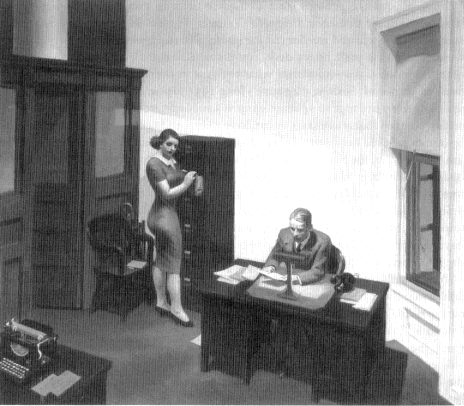
7.18
Edward Hopper, Office at Night , 1940. Oil on canvas, 22 3/16" × 25 3/16". Collection
Walker Art Center, Minneapolis.
space beneath her buttocks. With her pose and her dramatic black hair and makeup she oversteps the boundaries of charm to overtly sexual, and therefore questionable, behavior, which the fair-haired male checks by not meeting her gaze. Ironically, her eyes are so shaded by heavy makeup that her mysterious gaze can be (as Victor Burgin points out) either directed and predatory (hence filled with power) or downcast and modest (hence deferential). Although she appears able to move freely in the office, pictorially everything blocks her access to the seat of power behind the man's desk: the filing cabinet and desk intersect to create an unbridgeable gap. Another gap exists between her desk and his. She generates no activity but waits for instructions. Because the narrative is in suspension, the contradictions are not resolved.[66]
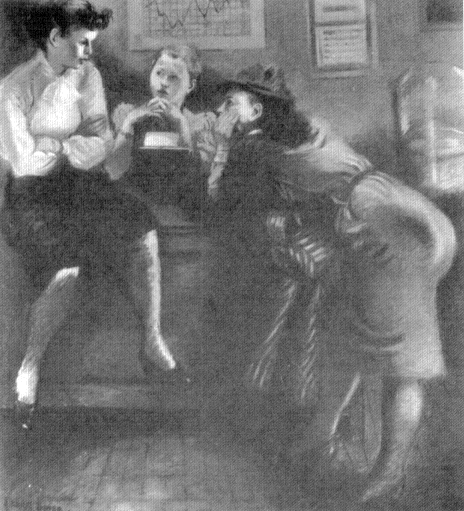
7.19
Isaac Soyer, Office Girls , 1939. Oil on canvas, 26" × 24". Present location unknown.
Although the clerical workers in Isaac Soyer's Office Girls (1939; Fig. 7.19) are absorbed in serious conversation, they too are placed before the viewer or office visitor as sexually attractive office ornaments. They congregate around a desk, where the central figure pauses momentarily over her typing. The legs of the woman on the left, exposed above the knee, are highlighted and silhouetted against the darker desk. The figure on the right bends over on a diagonal to prop her head in
her hands, her brightly illuminated, snugly clothed buttocks projecting toward the viewer. The pose, unselfconscious in an all-female group, acquires a heavy erotic subtext as the figure takes over the entire right side of the canvas.
Male artists like Soyer and Hopper focus on the office worker as ornamental and sexual, available to the male; Bishop refused to sexualize her models. Even though a degree of objectification occurs that can be read as a difference of class, Bishop still sees them as modest, pleasant young workers. Deferential behavior, it was argued, allowed women either to compete for jobs and rise through the ranks or to attract a man and retire from the workplace, the other avenue of success for the office worker. Against all feminist arguments that women worked for personal fulfillment and from economic need, the Fortune author asserted that the imitation of marriage explained and justified the existence of the female secretary, whereas the probability of marriage made women willing to work at low wages in positions where advancement was almost impossible.[67]
In the 1930s job counselors urged women to engage in social activities "with an eye out always for a satisfactory marriage." No one wanted to pound a typewriter forever, and women entering the field were encouraged to overlook the tediousness of the work since it would be temporary. Writers warned women against obvious office romances, and one counseled them not to set their sights on men beyond their own social station, for the rising executive was more interested in the "junior leaguer or the society girl outside."[68] Comments like these suggest that a persistent stigma—grounded in class bias—attached to the woman who worked.
Still, it was frequently argued that office girls made ideal wives. A woman office worker had studied the male temperament firsthand. Borrowing a page from the "companionate marriage" and professionalized homemaker manual, she understood that marriage resembled a business partnership. She also knew the importance of her husband's business relationships and would willingly entertain on short notice to further them. The wife, who had all the advantages of sharing a home with a man, could learn a great deal from the secretary, who did everything to make life easier for him:
A fault-finding wife who thinks only of her own selfish interests and what she can get out of her husband for herself or the children, is little better than the gold-digging stenographer whom she fears. Often a man becomes so fed up with discord at home . . . that he naturally turns to the girl who stands by him eight hours a day with praise instead of blame.... You very seldom see the wife who works shoulder to shoulder with her husband, who keeps herself pretty and attractive for his sake if not for her own, losing him to his secretary, or to any other woman.[69]
The ideology of woman's proper place permeated the advice literature for office workers and other job holders in the 1930s. Work was a preparation for marriage, a vehicle for finding a husband, and even a permissible pursuit for a wife if
an economic necessity. But it was rarely seen as a substitute for marriage. In Letters to Susan , an example of a popular form of advice literature in the 1930s, a middle-class mother responded to her college-age daughter who had been offered a training-level position in a chemistry lab. Susan was engaged to Mark; although her mother urged her to accept the position because economic conditions remained uncertain, marriage, she insisted, ought to be a woman's main job.
She ought to give it most of her time and the best of her energy, and she can't do it if she's employed and being paid to give just those same things to her employer.... A man needs his courage restored and a woman who works 8 hours can't do that. In marriage either husband or wife must be willing to make the outside the home needs of the other predominant.[70]
Preceding the letters in this volume, each of which addressed a different issue, was a preliminary essay entitled "The Situation," detailing the changed conditions in women's lives in the postwar world and offering some suggestions on how women should prepare for them. A woman's destiny was less clear than a man's because she had now to earn her own living and "manage her life successfully if someone else earns it for her." Unlike a man's life, hers was a gamble because she had to wait until her emotions "reached fulfillment" or until they were "permanently channeled into the pursuit of some major interest."[71]
Unlike a man, who actively selected his interests and goals from an array of possible choices, a woman was presumed to be concerned primarily with domestic life. Consequently, she had to await the right opportunity and react to it. She had to learn to respond to external stimuli—whether a male superior's work assignment or his social invitation—rather than develop skills that would allow her to initiate and direct her own behavior. To be selected by men for work and marriage and to be successful on the job and in the home, she had to display compliant, womanly qualities, and she had to wait. Furthermore, what she waited for was still dictated by an ideal of womanly service. Woman's work, at home or in the workplace, enhanced the lives of those around her: "Some kinds of women's work lead to the creation of beautiful things, some to the relief of distress and soothing of pain, some to the training of little minds, while still others go to the making of laughter or to the comfort and pleasure of all."[72]
Bishop's paintings often portray a young woman, in repose and relaxed, who waits or responds to stimuli around her. In such works as Laughing Head (Fig. 7.4) a solitary woman gazes at something beyond the confines of the picture and smiles or laughs. Within the picture plane she is unfettered because an ambiguous, shifting setting places no limits on her options; but these are the options of a temporary and transitional working life. The warm shimmering illumination that distinguishes the artist's painterly surfaces and sets her subjects' faces aglow suggests optimism, but it is so generalized that it in fact belies the inegalitarian conditions of office
workers' lives during the Depression. Bishop's paintings also avoid the tawdrier features or downtrodden side of Union Square that Marsh and Soyer more readily acknowledged.[73]
In devising strategies by which women could succeed in the white-collar business world, writers of advice manuals promoted a contradictory set of instructions. They perpetuated a patriarchal model of individual success based on competition—a model that was particularly strong in white-collar businesses in large cities like New York. This model assumed equal access to opportunity through hard work, thus downplaying both gender and class difference. Yet these writers also relied on and ultimately reinforced well-established conceptions of gender difference, particularly attitudes about a woman's nature, her capabilities, and the roles she could be expected to fill. The belief that a woman needed to be more womanly to get ahead, even if such behavior restricted her to feminized occupations, was held by men and women alike. Thankful for jobs during hard times, many women were willing to dress in the prescribed fashion, behave modestly, and ultimately ignore their fellow office workers' collective demands for better wages and working conditions. Writing in the Woman's Press and in Independent Woman , 1930s activists who struggled to improve the clerical worker's situation often met resistance from women schooled in the traditional models of "success" perpetuated in the advice literature.[74] As one writer summed up the situation, "Women who hope to be cooking their lunches in their own homes before the year is out are not women to be organized in unions for the improvement of their pay."[75]
Bishop's post-franchise generation of professional women believed equality was a matter of individual responsibility achieved within established institutions. Although Bishop herself believed strongly in "women" (many of her close friends were women artists), she did not advocate "feminism" in the sense of women's collective endeavors. She never participated in any women's organizations or separate exhibitions for women. Attempting to downplay gender difference in favor of individual achievement, she claimed she wanted to join the art world, not "to be a woman artist" but "just . . . to be an artist."[76]
Though she earned early critical and financial success in the mainstream art world—jurors for important national exhibitions awarded her prizes for both graphics and painting, and major museums purchased her works—she was always characterized as America's best woman artist. Moreover, critics placed careful limits around her achievement. Most reminded the public that she was Kenneth Hayes Miller's "pupil" and had made "slow" progress. Henry McBride spoke of Bishop working "the little plot of ground she has preempted" and of her "restricted" range. In 1937, one critic even claimed that Bishop's most obvious qualities were "modesty and charm."[77] Critics, colleagues, and friends alike attributed to her the very prerequisites for success that she had inscribed in her subjects.
Bishop became one of the first artists to give the office worker a place in the urban iconography of easel painting. Her images of these clerical types—stocky and unglamorous yet ennobled through artistic conventions that focused on a woman's figure and face—negotiate gender and class difference according to an ideology of office work whose sometimes contradictory notions of mobility and femininity were shared by the artist. Although she depicted her women as self-possessed individuals rather than sexualized objects, she never envisioned them as productive workers in the society in which she saw (and had herself seized) great opportunity. Nor did she see them suffering from an entrenched set of attitudes about roles and occupations. Both the occupational and social spaces of her lower-level workers remained distant from her own and she interacted with her subjects only as studio models. The ambiguous spatial envelope around her casually posed figures, however, suggests a contested middle-class ideal of femininity that has been destabilized by the Depression, a time when the demands of work and family were particularly acute. If Bishop's painterly suggestion of mobility and potential remains unconvincing as a metaphor for women's social or economic progress, it nonetheless embodies 1930s perceptions of mobility and femininity assigned to the young, deferential office worker whose proper working life was lived in a transitional space between the public and the domestic spheres. As visual representations of the contradictory discourse on women and work, Bishop's paintings helped to reinforce the belief that even outside the home, a woman had her proper place.